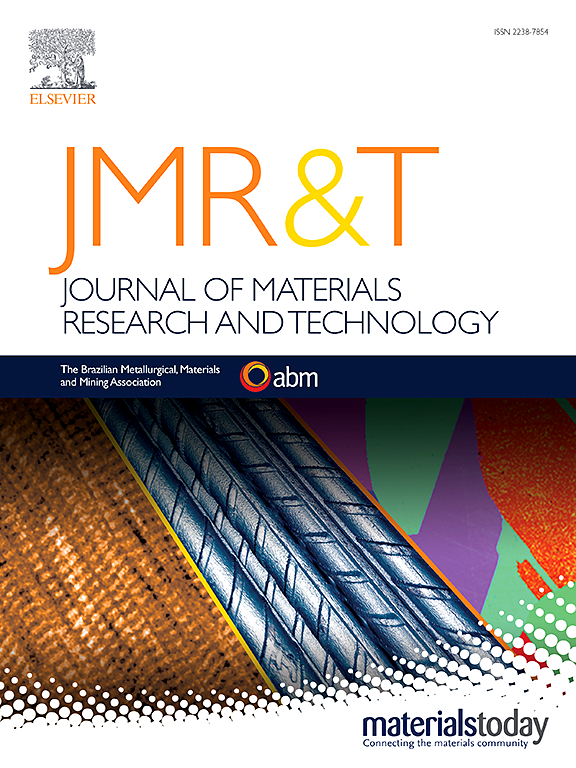共掺外加剂对大体积粉煤灰水泥复合材料水化及微观结构的影响
IF 6.2
2区 材料科学
Q1 MATERIALS SCIENCE, MULTIDISCIPLINARY
Journal of Materials Research and Technology-Jmr&t
Pub Date : 2025-06-04
DOI:10.1016/j.jmrt.2025.06.020
引用次数: 0
摘要
粉煤灰作为一种低碳材料,可以部分替代混凝土中的水泥,从而有助于减少二氧化碳排放和能源消耗。然而,大量粉煤灰(HVFA)的掺入通常会导致水泥基复合材料的早期强度显著下降,限制了其更广泛的应用。本研究考察了纳米二氧化硅(NS)分别与硅灰(SF)、偏高岭土(MK)、氧化石墨烯(GO)组成的二元体系对HVFA水泥复合材料强度发展的影响。通过对孔隙结构、相演化、界面过渡区元素分布和微观结构的分析,阐明了强度增强的潜在机制。实验结果表明,NS和MK分别减少了小孔和大孔的比例,SF减少了大孔和中孔的体积。此外,NS、SF和MK通过与氢氧化钙反应,有效地加速了火山灰反应,促进了水化产物的形成,导致ITZ凝胶中的Ca/Si比降低,微观结构更致密。在单一体系中,添加7.5% NS对7 d强度的改善最为显著,提高了148%,而添加15% SF对28 d强度的提高最大,达到74.2%。在二元体系中,7.5% NS和15% MK组合的7 d强度提高幅度最大,达到221%,而5% NS和15% SF组合的28 d强度提高幅度最大,达到115.9%。研究结果为推进可持续建筑材料的发展提供了有价值的参考。本文章由计算机程序翻译,如有差异,请以英文原文为准。
Effect of co-doped additives on the hydration and microstructure of high-volume fly ash cement composites
Fly ash, as a low-carbon material, can partially replace cement in concrete, thereby contributing to reductions in CO2 emissions and energy consumption. However, the incorporation of high-volume fly ash (HVFA) typically leads to a significant decline in the early strength of cement-based composites, limiting its broader application. This study investigated the influence of binary systems composed of nano-silica (NS) combined respectively with silica fume (SF), metakaolin (MK), or graphene oxide (GO) on the strength development of HVFA cement composites. The underlying mechanisms of strength enhancement were elucidated through analyses of pore structure, phase evolution, elemental distribution in the interfacial transition zone (ITZ), and microstructure. The experimental results demonstrated that NS and MK reduced the proportions of small and large pores, respectively, while SF decreased the volume of large and medium pores. Additionally, NS, SF, and MK effectively accelerated the pozzolanic reaction by reacting with calcium hydroxide, which promoted the formation of hydration products, leading to a reduced Ca/Si ratio in the ITZ gel and a denser microstructure. In single systems, the incorporation of 7.5 % NS yielded the most significant improvement in 7-d strength, with an increase of 148 %, while 15 % SF showed the greatest enhancement at 28 d, reaching 74.2 %. In binary systems, the combination of 7.5 % NS and 15 % MK achieved the highest 7-d strength improvement of 221 %, whereas the combination of 5 % NS and 15 % SF exhibited the most pronounced 28-d strength increase of 115.9 %. These findings offer valuable reference for advancing the development of sustainable construction materials.
求助全文
通过发布文献求助,成功后即可免费获取论文全文。
去求助
来源期刊

Journal of Materials Research and Technology-Jmr&t
Materials Science-Metals and Alloys
CiteScore
8.80
自引率
9.40%
发文量
1877
审稿时长
35 days
期刊介绍:
The Journal of Materials Research and Technology is a publication of ABM - Brazilian Metallurgical, Materials and Mining Association - and publishes four issues per year also with a free version online (www.jmrt.com.br). The journal provides an international medium for the publication of theoretical and experimental studies related to Metallurgy, Materials and Minerals research and technology. Appropriate submissions to the Journal of Materials Research and Technology should include scientific and/or engineering factors which affect processes and products in the Metallurgy, Materials and Mining areas.
 求助内容:
求助内容: 应助结果提醒方式:
应助结果提醒方式:


